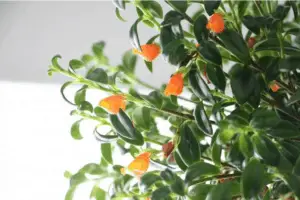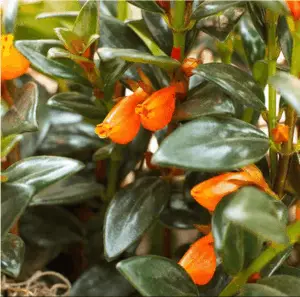What is Guppy plant?
The Guppy Plant (Nematanthus) is a small, trailing shrub known for its vibrant, tubular flowers that resemble tiny goldfish. Native to South America, it thrives in warm, humid environments and is often grown as a houseplant. With its cascading growth and glossy green leaves, the Guppy Plant makes a striking ornamental addition to indoor gardens.
How to grow a Goldfish plant?
You can grow guppy plants in your house, office, or garden.
Propagation through stem cuttings
The best time to propagate through stem cuttings is in spring and summer. The plant will easily root from stem cuttings.
- At first, choose a stem of guppy plant about 3-4 inches with no flowers.
- Place the cuttings in a bright and warm area. Avoid direct sunlight and keep it humid until you can observe new growth.
- Feed the plant weekly with a weak liquid fertilizer that includes micronutrients, during the growing season.
- The plant will flower in summer after propagation.
- Prune the stems after flowering. It helps to promote branching, give a bushier look, and grow quite thick and long branches.
- Similarly, in the case of outdoors, you can pinch off the stems to make it short about 2 feet tall, as the plant grows to about 3 feet high.
Here is a video on how to grow a goldfish plant via cutting.
How To Take Care of Guppy/Goldfish Plants?
- Lighting: Prefers bright, indirect sunlight. Too much direct sun can scorch the leaves, while too little light reduces flowering.
- Watering: Water when the top inch of soil is dry. Avoid overwatering, as Nematanthus is prone to root rot. Use well-draining soil.
- Temperature & Humidity: Keep temperatures between 18-26°C. This plant loves humidity, so misting or using a pebble tray can help.
- Fertilization: Feed with a balanced liquid fertilizer every 2-4 weeks during the growing season (spring and summer). Reduce feeding in winter.
- Pruning & Maintenance: Trim leggy stems to promote bushier growth and remove dead or yellowing leaves.
- Re-potting: The goldfish plants need to be re-potted every 2 to 3 years. You can gently root-prune the parent plant to encourage new root growth, and re-pot into slightly bigger pots.
- Insects and pests: Some insects such as aphids, spider mites, gray mold, and powdery mildew may infect the plant. You can treat them with insecticides and pesticides. You need to care about your plants attentively else you may encounter other significant problems like leggy growth, leaf drop, and lack of flowering, etc.
Where can I buy a Goldfish plant?
You can find a Goldfish plant for sale in amazon and get it delivered in your doorstep.

Amelia is a plant and nature lover! Ever since she was little, she loved spending time in her family’s garden and learning about how to care for each plant individually. As an adult, she has dedicated herself to sharing what she has learned and continuing to expand her knowledge on the plant kingdom.


